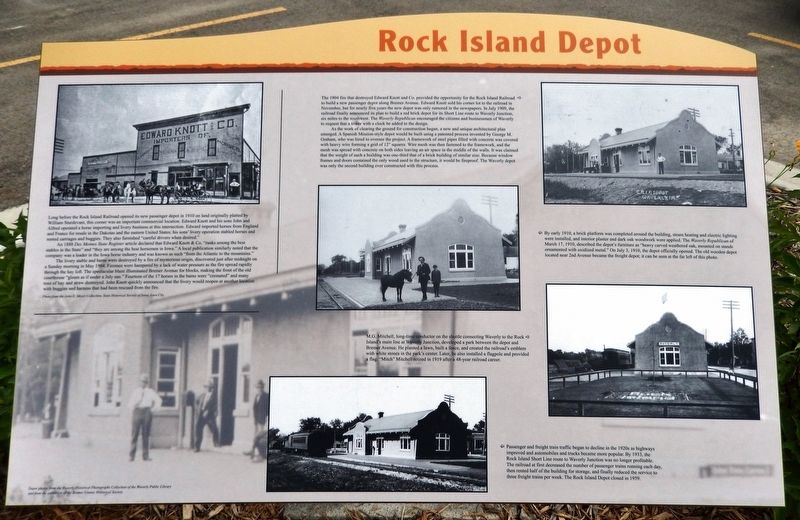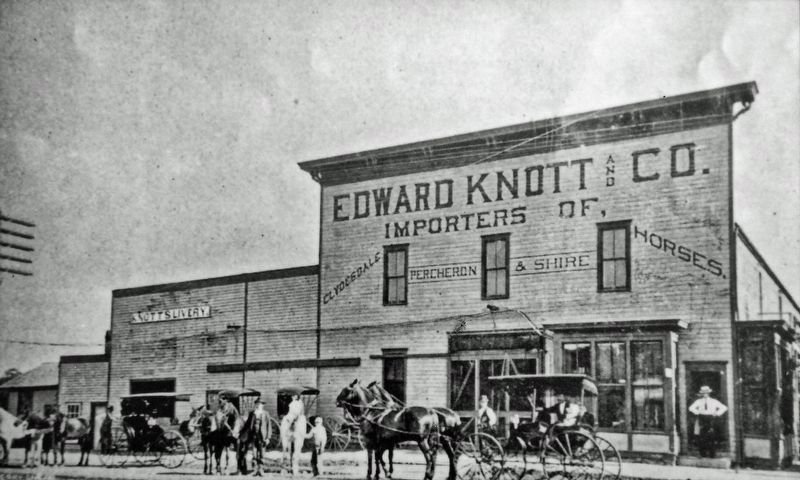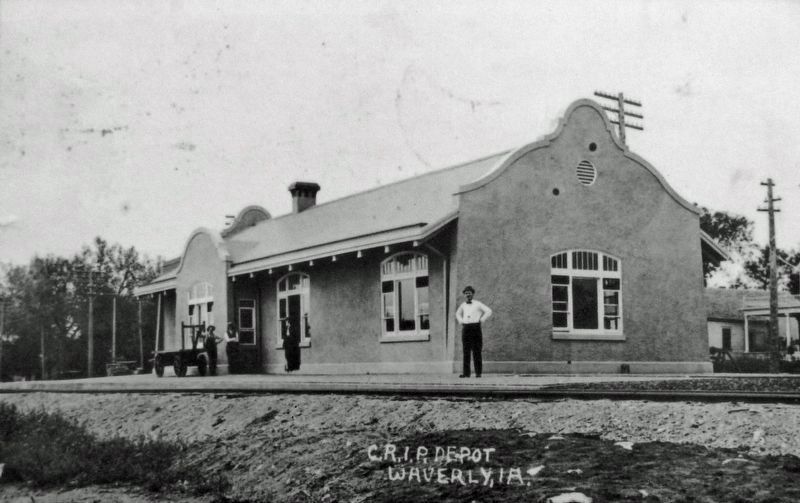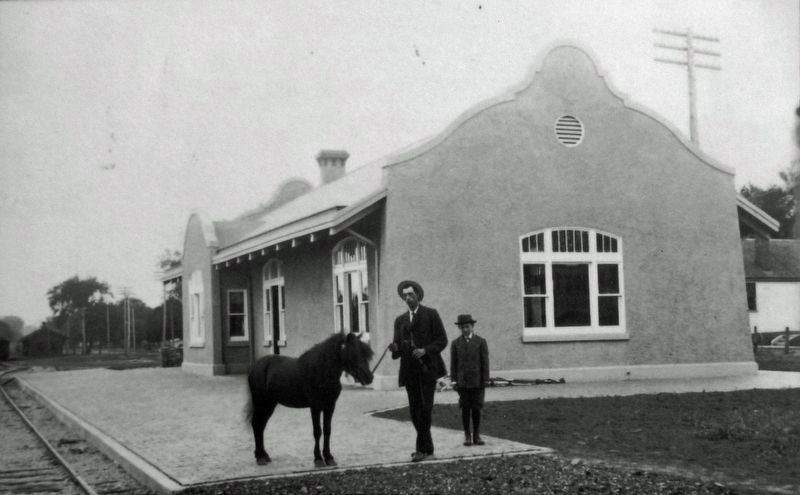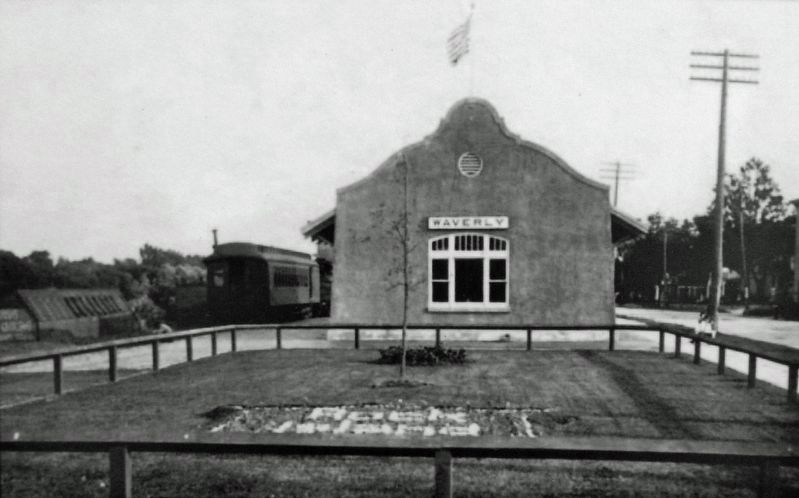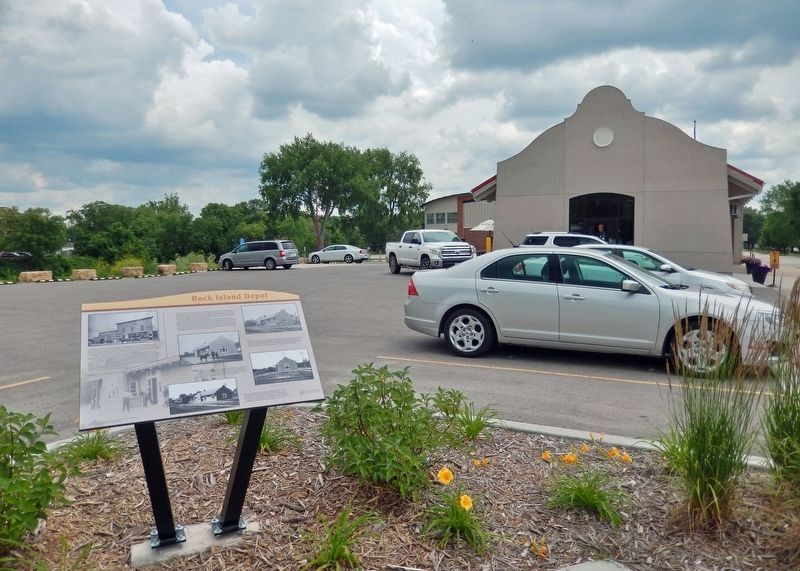Waverly in Bremer County, Iowa — The American Midwest (Upper Plains)
Rock Island Depot
An 1888 Des Moines State Register article declared that Edward Knott & Co. "ranks among the best stables in the State" and "they are among the best horsemen in Iowa." A local publication similarly noted that the company was a leader in the Iowa horse industry and was known as such "from the Atlantic to the mountains."
The livery stable and barns were destroyed by a fire of mysterious origin, discovered just after midnight on a Sunday morning in May 1904. Firemen were hampered by a lack of water pressure as the fire spread rapidly through the hay loft. The spectacular blaze illuminated Bremer Avenue for blocks, making the front of the old courthouse "gleam as if under a July sun." Fourteen of the 17 horses in the barns were "cremated" and many tons of hay and straw destroyed. John Knott quickly announced that the livery would reopen at another location with buggies and harness that had been rescued from the fire.
The 1904 fire that destroyed Edward Knott and Co. provided the opportunity for the Rock Island Railroad to build a new passenger depot along Bremer Avenue. Edward Knott sold his corner lot to the railroad in November, but for nearly five years the new depot was only rumored in the newspapers. In July 1909, the railroad finally announced its plan to build a red brick depot for its Short Line route to Waverly Junction, six miles to the southwest. The Waverly Republican encouraged the citizens and businessmen of Waverly to request that a tower with a clock be added to the design.
As the work of clearing the ground for construction began, a new and unique architectural plan emerged. A Spanish Mission-style depot would be built using a patented process invented by George M. Graham, who was hired to oversee the project. A framework of steel pipes filled with concrete was covered with heavy wire forming a grid of 12" squares. Wire mesh was then fastened to the framework, and the mesh was spread with concrete on both sides leaving an air space in the middle of the walls. It was claimed that the weight of such a building was one-third that of a brick building of similar size. Because window frames and doors contained the only wood used in the structure, it
would be fireproof. The Waverly depot was only the second building ever constructed with this process.
By early 1910, a brick platform was completed around the building, steam heating and electric lighting were installed, and interior plaster and dark oak woodwork were applied. The Waverly Republican of March 17, 1910, described the depot's furniture as "heavy carved weathered oak, mounted on stands ornamented with oxidized metal." On July 3, 1910, the depot officially opened. The old wooden depot located near 2nd Avenue became the freight depot; it can be seen at the far left of this photo.
M.G. Mitchell, long-time conductor on the shuttle connecting Waverly to the Rock Island's main line at Waverly Junction, developed a park between the depot and Bremer Avenue. He planted a lawn, built a fence, and created the railroad's emblem with white stones in the park's center. Later, he also installed a flagpole and provided a flag. "Mitch" Mitchell retired in 1919 after a 48-year railroad career.
Passenger and freight train traffic began to decline in the 1920s as highways improved and automobiles and trucks became more popular. By 1933, the Rock Island Short Line route to Waverly Junction was no longer profitable. The railroad at first decreased the number of passenger trains running each day, then rented half of the building for storage, and finally reduced the service to three freight trains per week. The Rock Island Depot closed in 1959.
Depot photos from the Waverly Historical Photographs Collection of the Waverly Public Library and from the collection of the Bremer County Historical Society.
Topics. This historical marker is listed in these topic lists: Architecture • Disasters • Industry & Commerce • Railroads & Streetcars. A significant historical date for this entry is July 3, 1910.
Location. 42° 43.536′ N, 92° 28.309′ W. Marker is in Waverly, Iowa, in Bremer County. Marker is at the intersection of 1st Street Southwest and East Bremer Avenue (State Route 3), on the right when traveling north on 1st Street Southwest. The marker is located beside the sidewalk at the southeast corner of the intersection. Touch for map. Marker is at or near this postal address: 109 1st Street Southwest, Waverly IA 50677, United States of America. Touch for directions.
Other nearby markers. At least 8 other markers are within walking distance of this marker. The Bremer Avenue Bridge over the Cedar River (within shouting distance of this marker); Waverly Cedar River Dam (within shouting distance of this marker); a different marker also named Waverly Cedar River Dam (about 300 feet away, measured in a direct line); a different marker also named Waverly Cedar River Dam (about 300 feet away); a different marker also named Waverly Cedar River Dam (about 300 feet away); Bremer County World War Memorial (approx. 0.3 miles away); Bremer County Korean & Vietnam War Memorial (approx. 0.3 miles away); Replica of the Statue of Liberty (approx. 0.3 miles away). Touch for a list and map of all markers in Waverly.
Regarding Rock Island Depot. From the Application for Waverly Historic Register submitted February 16, 2021, Accepted March 23, 2021.
Currently known as 4 Queens Dairy Cream (and over time, also as assorted businesses such as Laundry Depot, Quality Cleaners and Elsamiller Electric), the Rock Island Depot was erected in 1909-1910, under the supervision of George M. Graham. According to a June 10, 1910, newspaper article about the dedication of the new depot, Graham, head of Suspension Steel Construction Company in Chicago, owned the patent on the process for constructing buildings of this unique structural nature. The construction method sounds unusual and suggests an almost experimental forerunner of today’s metal studs that have replaced wood 2-by-4s in many projects. The concern with building fireproof depots presumably is linked to the fire danger of sparks thrown off by steam engines traveling so close to the buildings. The Rock Island line was apparently trying out this new patented construction method in Waverly.
Credits. This page was last revised on December 1, 2023. It was originally submitted on December 1, 2023, by Cosmos Mariner of Cape Canaveral, Florida. This page has been viewed 76 times since then and 29 times this year. Photos: 1, 2, 3, 4, 5, 6. submitted on December 1, 2023, by Cosmos Mariner of Cape Canaveral, Florida.
